The Angelbird Wings PX1 M.2 Adapter Review: Do M.2 SSDs Need Heatsinks?
by Billy Tallis on December 21, 2015 8:00 AM ESTSequential Write
Sequential writes are easier for the SSD controller to process than random writes, so throughput is almost always higher and the bottleneck in this test shifts more to the flash itself. This test puts the most intense load on the flash out of any of our tests, and usually produces the highest overall power consumption. The timing of the sub-tests is the same as for the random tests, and the drive is filled before the test so that features like SLC write caching don't distort the beginning of the test.
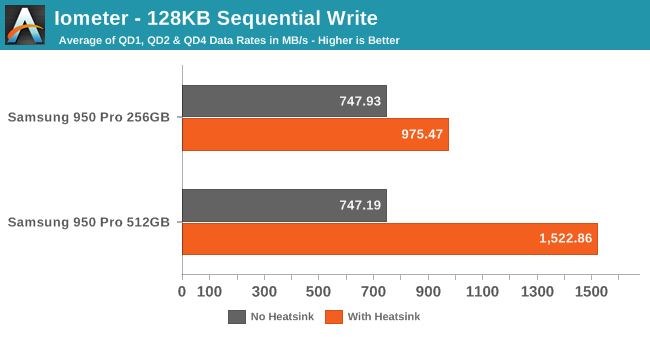
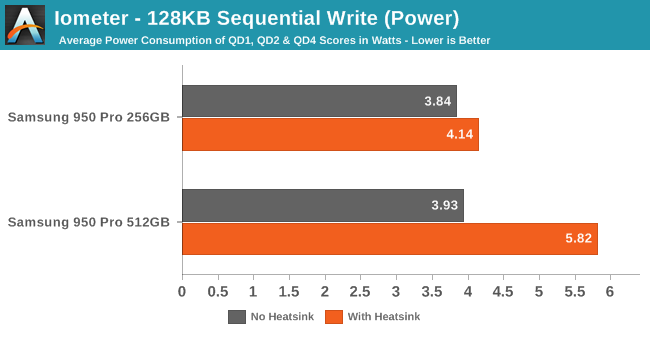
The heatsink provides a nice boost to the 256GB 950 Pro's sequential write speed, but doubles the sustained performance of the 512GB model. Power efficiency is still improved, especially for the 512GB drive, but it's now reaching almost 6W.
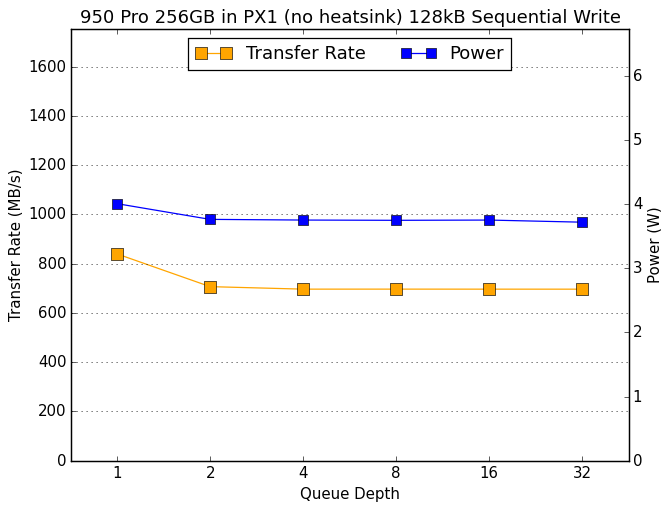 |
|||||||||
| 256GB no heatsink | 512GB no heatsink | ||||||||
| 256GB with heatsink | 512GB with heatsink | ||||||||
Without the heatsink, both drives experience thermal throttling only a few minutes into the test, with QD2 performance lower than QD1. With the heatsink, both drives show steady performance across the entire test. The 256GB improves QD1 performance slightly while the 512GB drive sees a 73% increase in QD1 performance. At queue depths greater than one the performance improvements are even larger.
Sequential Read
With the lower overhead of sequential operations and the inherent speed advantage reads have over writes, the sequential read test usually produces the highest throughput numbers. For SATA drives nowadays this usually means the SATA interface itself is the bottleneck, but even with NVMe we haven't seen a drive yet saturate the bandwidth of a PCIe 3.0 x4 link. Depending on the drive, this test could be limited by bottlenecks in the SSD controller's host interface or its connections to the flash memory.
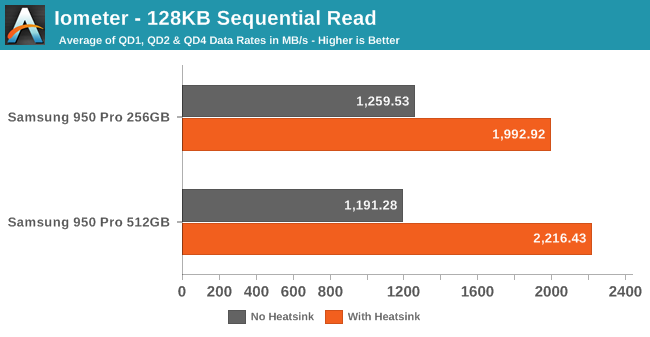

Both capacities see significant gains in sequential read performance, accompanied by smaller but still significant increases in power consumption. The 512GB drive once again manages to double sustained performance, and the 256GB improves by 58%.
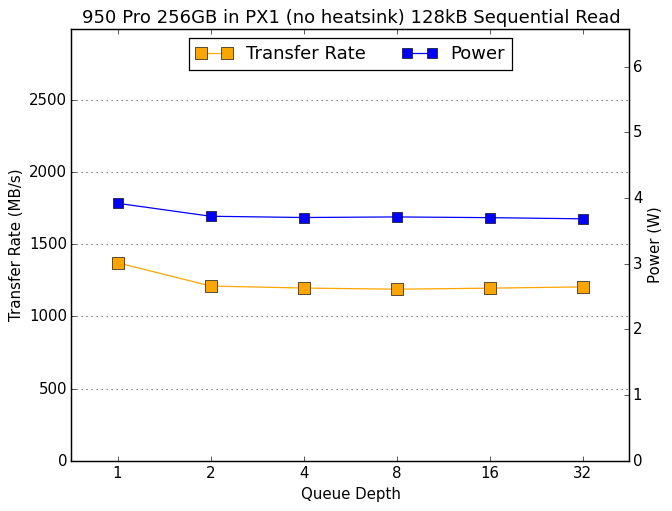 |
|||||||||
| 256GB no heatsink | 512GB no heatsink | ||||||||
| 256GB with heatsink | 512GB with heatsink | ||||||||
Again we see that the drives can't scale with higher queue depths when they're thermally constrained, but when properly cooled they perform superbly with any queue depth larger than one. The 512GB drive manages to deliver slightly more than 2.6GB/s read speed, well above what can be achieved with PCIe 2.0 x4 and about two thirds of the capacity of the PCIe 3.0 x4 link used by the 950 Pro.










69 Comments
View All Comments
Ryan Smith - Monday, December 21, 2015 - link
That is actually correct. The drives are more consistent when they thermally throttle because the controller has plenty of time to catch up. Whereas with a heatsink they're running at full tilt, and sometimes the controller has trouble keeping things consistent.tipoo - Monday, December 21, 2015 - link
Huh, interesting.tipoo - Monday, December 21, 2015 - link
So why is the scenario the exact flip on the 256GB drive? Did it just finish the test sooner?Billy Tallis - Monday, December 21, 2015 - link
During thermal throttling, the 256GB was occasionally stuttering and dropping from 6k IOPS to 2k IOPS. That tanked the consistency score. The 512GB's performance regulation when thermally throttled was basically perfect—during steady state it never deviated from ~6k IOPS.Magichands8 - Monday, December 21, 2015 - link
I really don't get why so many people seem to love M.2 so much. Sure it's convenient for laptops but for just about anything else it's a severely limited form factor restricting capacity and adding heat issues while eating up precious expansion slot space on the motherboard. What I'd really like to see are U.2 SSDs with 10 times the capacity.nwarawa - Monday, December 21, 2015 - link
The performance is obvious plateauing with that heatsink, so it begs the question: what is good enough? I assume it's just the controller that needs to be cooled. Would one of those tiny chipset heatsinks with some thermal tape still see most, if not all, the benefit of this Angelbird heatsink?Billy Tallis - Monday, December 21, 2015 - link
Given sufficient airflow, I think one of those small heatsinks could get the job done. I don't think most M.2 slots or adapters put the drive in a position to receive that much airflow unless your case is already a serious wind tunnel.damianrobertjones - Monday, December 21, 2015 - link
"The M.2 form factor has quickly established itself as the most popular choice for PCIe SSDs in the consumer space. "How do you know this? I'd still rather buy a 950 Pro 2.5" than an M.2. (I do own both though)
moozooh - Monday, December 21, 2015 - link
"PCIe to M.2 adapter"Shouldn't it be "M.2 to PCIe adapter"? Since, you know, it adapts an M.2 device to a PCIe slot but not the opposite.
Billy Tallis - Monday, December 21, 2015 - link
I was looking at it as making a PCIe slot into an M.2 slot into which you'd insert the drive, as opposed to thinking of it as something modifying the drive. I can see how a consumer pairing it with a particular drive would take the other perspective, but to me the adapter is the permanent part of the testbed and the drives are transient occupants.